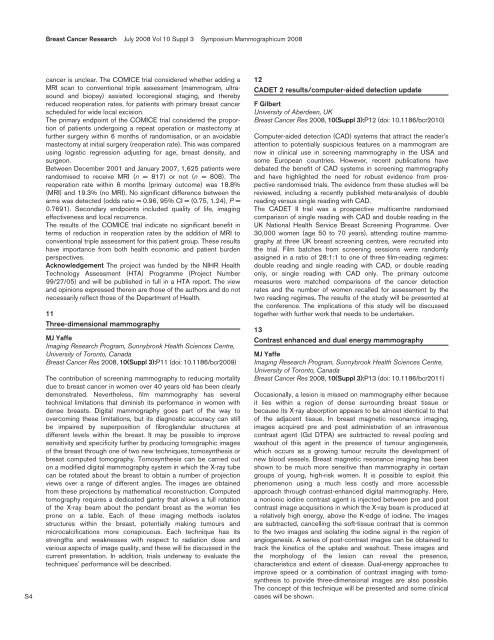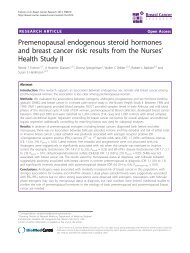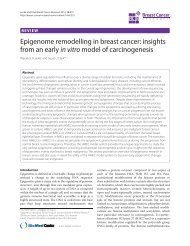Ultrasound-guided axillary node core biopsy - Breast Cancer ...
Ultrasound-guided axillary node core biopsy - Breast Cancer ...
Ultrasound-guided axillary node core biopsy - Breast Cancer ...
You also want an ePaper? Increase the reach of your titles
YUMPU automatically turns print PDFs into web optimized ePapers that Google loves.
<strong>Breast</strong> <strong>Cancer</strong> Research July 2008 Vol 10 Suppl 3 Symposium Mammographicum 2008<br />
S4<br />
cancer is unclear. The COMICE trial considered whether adding a<br />
MRI scan to conventional triple assessment (mammogram, ultrasound<br />
and <strong>biopsy</strong>) assisted lo<strong>core</strong>gional staging, and thereby<br />
reduced reoperation rates, for patients with primary breast cancer<br />
scheduled for wide local excision.<br />
The primary endpoint of the COMICE trial considered the proportion<br />
of patients undergoing a repeat operation or mastectomy at<br />
further surgery within 6 months of randomisation, or an avoidable<br />
mastectomy at initial surgery (reoperation rate). This was compared<br />
using logistic regression adjusting for age, breast density, and<br />
surgeon.<br />
Between December 2001 and January 2007, 1,625 patients were<br />
randomised to receive MRI (n = 817) or not (n = 808). The<br />
reoperation rate within 6 months (primary outcome) was 18.8%<br />
(MRI) and 19.3% (no MRI). No significant difference between the<br />
arms was detected (odds ratio = 0.96, 95% CI = (0.75, 1.24), P =<br />
0.7691). Secondary endpoints included quality of life, imaging<br />
effectiveness and local recurrence.<br />
The results of the COMICE trial indicate no significant benefit in<br />
terms of reduction in reoperation rates by the addition of MRI to<br />
conventional triple assessment for this patient group. These results<br />
have importance from both health economic and patient burden<br />
perspectives.<br />
Acknowledgement The project was funded by the NIHR Health<br />
Technology Assessment (HTA) Programme (Project Number<br />
99/27/05) and will be published in full in a HTA report. The view<br />
and opinions expressed therein are those of the authors and do not<br />
necessarily reflect those of the Department of Health.<br />
11<br />
Three-dimensional mammography<br />
MJ Yaffe<br />
Imaging Research Program, Sunnybrook Health Sciences Centre,<br />
University of Toronto, Canada<br />
<strong>Breast</strong> <strong>Cancer</strong> Res 2008, 10(Suppl 3):P11 (doi: 10.1186/bcr2009)<br />
The contribution of screening mammography to reducing mortality<br />
due to breast cancer in women over 40 years old has been clearly<br />
demonstrated. Nevertheless, film mammography has several<br />
technical limitations that diminish its performance in women with<br />
dense breasts. Digital mammography goes part of the way to<br />
overcoming these limitations, but its diagnostic accuracy can still<br />
be impaired by superposition of fibroglandular structures at<br />
different levels within the breast. It may be possible to improve<br />
sensitivity and specificity further by producing tomographic images<br />
of the breast through one of two new techniques, tomosynthesis or<br />
breast computed tomography. Tomosynthesis can be carried out<br />
on a modified digital mammography system in which the X-ray tube<br />
can be rotated about the breast to obtain a number of projection<br />
views over a range of different angles. The images are obtained<br />
from these projections by mathematical reconstruction. Computed<br />
tomography requires a dedicated gantry that allows a full rotation<br />
of the X-ray beam about the pendant breast as the woman lies<br />
prone on a table. Each of these imaging methods isolates<br />
structures within the breast, potentially making tumours and<br />
microcalcifications more conspicuous. Each technique has its<br />
strengths and weaknesses with respect to radiation dose and<br />
various aspects of image quality, and these will be discussed in the<br />
current presentation. In addition, trials underway to evaluate the<br />
techniques’ performance will be described.<br />
12<br />
CADET 2 results/computer-aided detection update<br />
F Gilbert<br />
University of Aberdeen, UK<br />
<strong>Breast</strong> <strong>Cancer</strong> Res 2008, 10(Suppl 3):P12 (doi: 10.1186/bcr2010)<br />
Computer-aided detection (CAD) systems that attract the reader’s<br />
attention to potentially suspicious features on a mammogram are<br />
now in clinical use in screening mammography in the USA and<br />
some European countries. However, recent publications have<br />
debated the benefit of CAD systems in screening mammography<br />
and have highlighted the need for robust evidence from prospective<br />
randomised trials. The evidence from these studies will be<br />
reviewed, including a recently published meta-analysis of double<br />
reading versus single reading with CAD.<br />
The CADET II trial was a prospective multicentre randomised<br />
comparison of single reading with CAD and double reading in the<br />
UK National Health Service <strong>Breast</strong> Screening Programme. Over<br />
30,000 women (age 50 to 70 years), attending routine mammography<br />
at three UK breast screening centres, were recruited into<br />
the trial. Film batches from screening sessions were randomly<br />
assigned in a ratio of 28:1:1 to one of three film-reading regimes:<br />
double reading and single reading with CAD, or double reading<br />
only, or single reading with CAD only. The primary outcome<br />
measures were matched comparisons of the cancer detection<br />
rates and the number of women recalled for assessment by the<br />
two reading regimes. The results of the study will be presented at<br />
the conference. The implications of this study will be discussed<br />
together with further work that needs to be undertaken.<br />
13<br />
Contrast enhanced and dual energy mammography<br />
MJ Yaffe<br />
Imaging Research Program, Sunnybrook Health Sciences Centre,<br />
University of Toronto, Canada<br />
<strong>Breast</strong> <strong>Cancer</strong> Res 2008, 10(Suppl 3):P13 (doi: 10.1186/bcr2011)<br />
Occasionally, a lesion is missed on mammography either because<br />
it lies within a region of dense surrounding breast tissue or<br />
because its X-ray absorption appears to be almost identical to that<br />
of the adjacent tissue. In breast magnetic resonance imaging,<br />
images acquired pre and post administration of an intravenous<br />
contrast agent (Gd DTPA) are subtracted to reveal pooling and<br />
washout of this agent in the presence of tumour angiogenesis,<br />
which occurs as a growing tumour recruits the development of<br />
new blood vessels. <strong>Breast</strong> magnetic resonance imaging has been<br />
shown to be much more sensitive than mammography in certain<br />
groups of young, high-risk women. It is possible to exploit this<br />
phenomenon using a much less costly and more accessible<br />
approach through contrast-enhanced digital mammography. Here,<br />
a nonionic iodine contrast agent is injected between pre and post<br />
contrast image acquisitions in which the X-ray beam is produced at<br />
a relatively high energy, above the K-edge of iodine. The images<br />
are subtracted, cancelling the soft-tissue contrast that is common<br />
to the two images and isolating the iodine signal in the region of<br />
angiogenesis. A series of post-contrast images can be obtained to<br />
track the kinetics of the uptake and washout. These images and<br />
the morphology of the lesion can reveal the presence,<br />
characteristics and extent of disease. Dual-energy approaches to<br />
improve speed or a combination of contrast imaging with tomosynthesis<br />
to provide three-dimensional images are also possible.<br />
The concept of this technique will be presented and some clinical<br />
cases will be shown.






